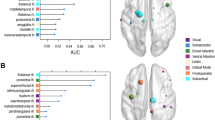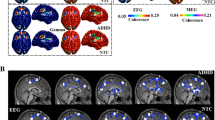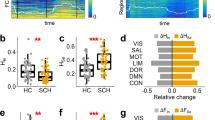Abstract
In recent times, the complex network theory is increasingly applied to characterize, classify, and diagnose a broad spectrum of neuropathological conditions, including attention deficit hyperactivity disorder (ADHD), Alzheimer’s disease, bipolar disorder, and many others. Nevertheless, the diagnosis and associated subtype identification majorly rely on the baseline correlation matrix obtained from the functional MRI scan. Thus, the existing protocols are either full of personalized bias or computationally expensive as network complexity-based simple but deterministic protocols are yet to be developed and formalized. This article proposes a deterministic method to identify and differentiate the common ADHD subtypes, which is based on a single complexity measure, namely the eigenvector centrality. The node-wise centrality differences were explored using a classification tree model (p < 0.05) to diagnose the subtypes. Identification of marker nodes from default mode, visual, frontoparietal, limbic, and cerebellar networks strongly vouch for the involvement of multiple brain regions in ADHD neuropathology.






Similar content being viewed by others
References
Griffiths K, Grieve S, Kohn M et al (2016) Altered gray matter organization in children and adolescents with ADHD: a structural covariance connectome study. Transl Psychiatry 6:e947
Polanczyk G, de Lima MS, Horta BL, Biederman J, Rohde LA (2007) The worldwide prevalence of ADHD: a systematic review and metaregression analysis. Am J Psychiatry 164:942–948
Castellanos FX, Proal E (2012) E “Large-scale brain systems in ADHD: beyond the prefrontal-striatal model.” Trends Cogn Sci 16:17–26
Goodman DW, Mitchell S, Rhodewalt L, Surman CBH (2016) Clinical presentation, diagnosis and treatment of attention-deficit hyperactivity disorder (ADHD) in older adults: a review of the evidence and its implications for clinical care. Drugs Aging 33:27–36
Gualtieri CT, Johnson LG (2005) ADHD: is objective diagnosis possible? Psychiatry (Edgmont) 2:44–53
Goldman LS, Genel M, Bezman RJ, Slanetz PJ (1998) Diagnosis and treatment of attention-deficit/hyperactivity disorder in children and adolescents. JAMA 279:1100–1107
Costa Dias TG, Iyer SP, Carpenter SD, Cary RP, Wilson VB, Mitchell SH et al (2015) Characterizing heterogeneity in children with and without ADHD based on reward system connectivity. Dev Cogn Neurosci 11:155–174
Mills BD, Miran-Dominguez O, Mills KL, Earl E, Cordova M, Painter J et al (2018) ADHD and attentional control: impaired segregation of task positive and task negative brain networks. Netw Neurosci 2:200–217
Tian L, Jiang T, Liang M, Zang Y, He Y, Sui M et al (2008) Enhanced resting-state brain activities in ADHD patients: a fMRI study. Brain Dev 30:342–348
Sutcubasi B, Metin B, Kurban MK, Metin ZE, Beser B, Sonuga-Barke E (2020) Resting-state network dysconnectivity in ADHD: a system-neuroscience-based meta-analysis. World J Biol Psychiatry 21:662–672
Stevens SE, Sonuga-Barke EJS, Kreppner JM, Beckett C, Castle J, Colvert E et al (2008) Inattention/overactivity following early severe institutional deprivation: presentation and associations in early adolescence. J Abnorm Child Psychol 36:385–398
Fair DA, Bathula D, Nikolas MA, Nigg JT (2012) Distinct neuropsychological subgroups in typically develo** youth inform heterogeneity in children with ADHD. PNAS 109:6769–6774
Humphries MD, Gurney K (2008) Network ‘small-world-ness’: a quantitative method for determining canonical network equivalence. PLoS ONE 3:e0002051
Cao M, Shu N, Cao Q, Wang Y, He Y (2014) Imaging functional and structural brain connectomics in attention-deficit/hyperactivity disorder. Mol Neurobiol 50:1111–1123
Saad JF, Griffiths KR, Kohn MR, Clarke S, Williams LM, Korgaonkar MS (2017) Regional brain network organization distinguishes the combined and inattentive subtypes of attention deficit hyperactivity disorder. Neuroimage Clin 15:383–390
Guimerà R, Mossa S, Turtschi A, Amaral LAN (2005) The worldwide air transportation network: anomalous centrality, community structure, and cities’ global roles. PNAS 102:7794–7799
Costa LF et al (2011) Analyzing and modelling real-world phenomena with complex networks: a survey of applications. Adv Phys 60:329–412
Oldham S, Fulcher B, Parkes L, Arnatkevic̆iūtė A, Suo C, Fornito A (2019) Consistency and differences between centrality measures across distinct classes of networks. PLoS ONE 14:e0220061
Langville AN, Meyer CD (2006) Google’s PageRank and Beyond: The Science of Search Engine Rankings”. Princeton University Press, Princeton
Bonacich P (2007) Some unique properties of eigenvector centrality. Social Networks 29:555–564
Lohmann G et al (2010) Eigenvector centrality map** for analyzing connectivity patterns in fMRI data of the human brain. PLoS ONE 5:e10232
Binnewijzend MAA et al (2014) Brain network alterations in Alzheimer’s disease measured by eigenvector centrality in fMRI are related to cognition and CSF biomarkers. Hum Brain Mapp 35:2383–2393
Eijlers AJC et al (2017) Increased default-mode network centrality in cognitively impaired multiple sclerosis patients. Neurology 88:952–960
Breiman L, Friedman J, Stone CJ, Olshen RA (1984) Classification and Regression Trees, 1st edn. Chapman and Hall, CRC
Findley S (2003) Age limits and adolescents. Paediatr Child Health 8:577–578
Bullmore E, Sporns O (2009) Complex brain networks: graph theoretical analysis of structural and functional systems. Neuroscience 10:186–198
Rubinov M, Sporns O (2010) Complex network measures of brain connectivity: uses and interpretations. Neuroimage 52:1059–1069
Craddock RC et al (2012) A whole brain fMRI atlas generated via spatially constrained spectral clustering. Hum Brain Mapp 33:1914–1928
Perron O (1997) Zur theorie der matrizen. Math Ann 64:248–263
Frobenius G (1912) Uber matrizen aus nicht negativen elementen. S-B Preuss Acad Wiss, Berlin
Fletcher JMK, Wennekers T (2017) From structure to activity: using centrality measures to predict neuronal activity. Int J Neural Syst 28:1750013
Colbourn CJ, Kreher DL (1996) “Concerning Difference Matrices. In: Tonchev V (ed) Codes Designs and Geometry”. Springer, Boston
Raileanu LE, Stoffel K (2004) Theoretical comparison between the gini index and information gain criteria. Ann Math Artif Intell 41:77–93
Richiardi H et al (2010) Brain decoding of fMRI connectivity graphs using decision tree ensembles. IEEE Int Symp Biomed Imaging: from Nano Macro 2010:1137–1140
Sadria M, Karimi S, Layton AT (2019) Network centrality analysis of eye-gaze data in autism spectrum disorder. Comput Biol Med 111(7):103332
Nakai Y, Nishibayashi H, Donishi T et al (2021) Regional abnormality of functional connectivity is associated with clinical manifestations in individuals with intractable focal epilepsy. Sci Rep 11:1545
Duinkerken E et al (2017) Altered eigenvector centrality is related to local resting-state network functional connectivity in patients with longstanding type 1 diabetes mellitus. Hum Brain Mapp 38:3623–3636
Wink AM (2019) Eigenvector centrality dynamics from resting-state fMRI: gender and age differences in healthy subjects. Front Neurosci 13:648
Yu-Feng Z et al (2007) Altered baseline brain activity in children with ADHD revealed by resting-state functional MRI. Brain Develop 29:83–91
Gong G, He Y, Evans AC (2011) Brain connectivity: gender makes a difference. Neuroscientist 17:575–591
Filippi M (2013) The organization of intrinsic brain activity differs between genders: a resting-state fMRI study in a large cohort of young healthy subjects. Hum Brain Map 34:1330–1343
Smith DV et al (2014) Characterizing individual differences in functional connectivity using dual-regression and seed-based approaches. Neuroimage 95:1–12
Alonso-Nanclares L et al (2008) Gender differences in human cortical synaptic density. PNAS 105:14615–14619
Ritchie SJ et al (2018) Sex differences in the adult human brain: evidence from 5216 UK biobank participants. Cereb Cortex 28:2959–2975
Author information
Authors and Affiliations
Contributions
Both PS and DS have conceptualized the topic, followed up the experiments and statistical analysis. Both of them also drafted the manuscript.
Corresponding author
Ethics declarations
Conflicts of interest
The authors declare that they have no conflicts of interest. This research did not receive any specific grant from funding agencies in the public, commercial, or not-for-profit sectors.
Additional information
Publisher's Note
Springer Nature remains neutral with regard to jurisdictional claims in published maps and institutional affiliations.
Supplementary Information
Below is the link to the electronic supplementary material.
Rights and permissions
Springer Nature or its licensor holds exclusive rights to this article under a publishing agreement with the author(s) or other rightsholder(s); author self-archiving of the accepted manuscript version of this article is solely governed by the terms of such publishing agreement and applicable law.
About this article
Cite this article
Saha, P., Sarkar, D. Characterization and Classification of ADHD Subtypes: An Approach Based on the Nodal Distribution of Eigenvector Centrality and Classification Tree Model. Child Psychiatry Hum Dev 55, 622–634 (2024). https://doi.org/10.1007/s10578-022-01432-6
Accepted:
Published:
Issue Date:
DOI: https://doi.org/10.1007/s10578-022-01432-6




